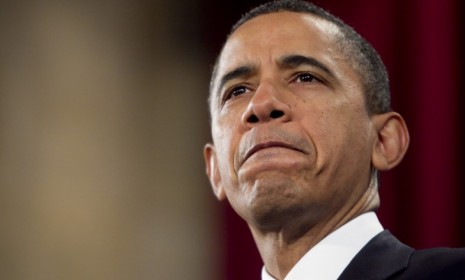April's disappointing jobs report: 6 takeaways
The unemployment rate falls to 8.1 percent, but the economy adds only a meager 115,000 jobs, fueling concerns that the recovery is stalling once again

The jobless rate in April fell to 8.1 percent, its lowest level since President Obama took office in 2009... but don't expect the White House to start whipping up champagne cocktails. The stubborn economy added a worse-than-expected 115,000 jobs last month, not nearly enough for the labor market to claw its way out of its deep hole. Indeed, many analysts now fear that we're living through a rerun of what happened to the economy in early 2010 and early 2011, when the recovery appeared to be accelerating only to stumble and lurch. Here, six takeaways from the latest jobs report:
1. Labor force participation is at a three-decade low
The jobless rate fell in April because 342,000 out-of-work Americans stopped looking for work altogether; thus, the government didn't count them as being unemployed. The percentage of Americans in the workforce is now just 63.6 percent — the lowest level since December 1981, and an unmistakable signal that the job market is still in the dumps.
The Week
Escape your echo chamber. Get the facts behind the news, plus analysis from multiple perspectives.

Sign up for The Week's Free Newsletters
From our morning news briefing to a weekly Good News Newsletter, get the best of The Week delivered directly to your inbox.
From our morning news briefing to a weekly Good News Newsletter, get the best of The Week delivered directly to your inbox.
2. The government continues to shed jobs
The public sector, forced to cut workers to close budget deficits, continues to hamper the labor market. Government employment fell by 15,000 jobs, while the private sector added 130,000.
3. Businesses are making do with less
The economy "is producing even more goods and services than it did when the recession officially began in December 2007, but with about five million fewer workers," says Catherine Rampell at The New York Times. That means adaptable companies are getting more out of the workers they have, and exploiting new technologies. However, productivity actually fell slightly in April, suggesting it may no longer be tenable "to get more work out of the existing staff," says Peter Coy at Bloomberg Businessweek. If demand rises, companies could start hiring more.
A free daily email with the biggest news stories of the day – and the best features from TheWeek.com
4. There are still reasons for optimism…
Revised data reveals that the economy created more jobs in February and March than previously thought. (February's numbers were revised from 240,000 to 259,000 and March's from 120,000 to 154,000.) That could mean that the mild winter triggered an unusual boost in off-season hiring, negating the need to find workers in spring, when economists usually expect hiring to ramp up.
5. …And plenty of reasons to worry
The economy faces several obstacles that could squelch the recovery, including high gas prices, Europe's ongoing debt crisis, and slowing growth in China which could reduce demand for American goods and services.
6. The economy is still Obama's Achilles' heel
The White House says the April jobs report is "further evidence that the economy is continuing to heal," but it's clear Obama will head into November with a relatively high unemployment rate. Mitt Romney, the presumptive GOP nominee, blasted Obama for his economic stewardship, saying the jobs report was "terrible and very disappointing." These numbers allow Romney "to get back on message," after being embroiled recently in arguments over Osama bin Laden and national security that don't play to his strengths, says MSNBC's First Read.
Sources: Associated Press, Bloomberg Businessweek, MSNBC, The New York Times, Politico, TalkingPointsMemo, The Wall Street Journal, The Washington Post
-
 What would a UK deployment to Ukraine look like?
What would a UK deployment to Ukraine look like?Today's Big Question Security agreement commits British and French forces in event of ceasefire
-
 Nicolás Maduro: from bus driver to Venezuela’s president
Nicolás Maduro: from bus driver to Venezuela’s presidentIn the Spotlight Shock capture by US special forces comes after Maduro’s 12-year rule proved that ‘underestimating him was a mistake’
-
 Artemis II: back to the Moon
Artemis II: back to the MoonThe Explainer Four astronauts will soon be blasting off into deep space – the first to do so in half a century